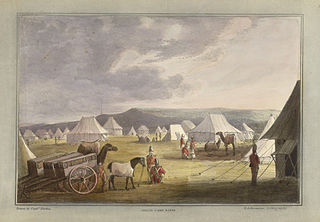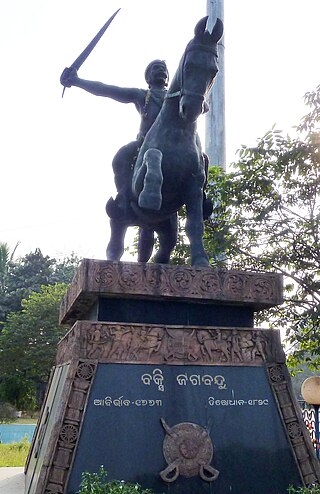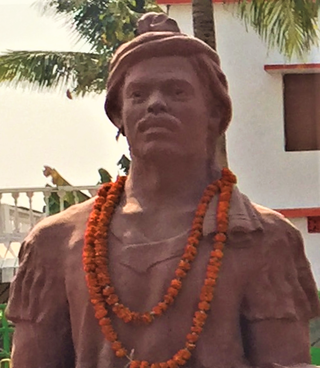| |||||
| Centuries: | |||||
|---|---|---|---|---|---|
| Decades: | |||||
| See also: | List of years in India Timeline of Indian history | ||||
Events in the year 1817 in India.
| |||||
| Centuries: | |||||
|---|---|---|---|---|---|
| Decades: | |||||
| See also: | List of years in India Timeline of Indian history | ||||
Events in the year 1817 in India.
| | This section is empty. You can help by adding to it. (March 2022) |

Chakravarti Rajagopalachari BR, popularly known as Rajaji or C.R., also known as Mootharignar Rajaji, was an Indian statesman, writer, lawyer, and independence activist. Rajagopalachari was the last Governor-General of India, as when India became a republic in 1950 the office was abolished. He was also the only Indian-born Governor-General, as all previous holders of the post were British nationals. He also served as leader of the Indian National Congress, Premier of the Madras Presidency, Governor of West Bengal, Minister for Home Affairs of the Indian Union and Chief Minister of Madras state. Rajagopalachari founded the Swatantra Party and was one of the first recipients of India's highest civilian award, the Bharat Ratna. He vehemently opposed the use of nuclear weapons and was a proponent of world peace and disarmament. During his lifetime, he also acquired the nickname 'Mango of Salem'.

India is a federal union comprising 28 states and 8 union territories, for a total of 36 entities. The states and union territories are further subdivided into districts and smaller administrative divisions.

The Third Anglo-Maratha War (1817–1819) was the final and decisive conflict between the British East India Company and the Maratha Empire in India. The war left the Company in control of most of India. It began with an invasion of Maratha territory by British East India Company troops, and although the British were outnumbered, the Maratha army was decimated. The troops were led by Governor General Hastings, supported by a force under General Thomas Hislop. Operations began against the Pindaris, a band of Muslim mercenaries and Marathas from central India.
Events in the year 1857 in India.
The 102nd Regiment of Foot was a regiment of the British Army raised by the Honourable East India Company in 1742. It transferred to the command of the British Army in 1862. Under the Childers Reforms it amalgamated with the 103rd Regiment of Foot in 1881 to form the Royal Dublin Fusiliers.

B.S. Abdur Rahman Crescent Institute of Science and Technology, formerly B. S. Abdur Rahman University, is a private deemed university located in Tamil Nadu, India. Previously, functioning under University of Madras (1984–2001) and Anna University (2001–09) as Crescent Engineering College, the institute gained deemed status in 2008–09. It is located in Vandalur near Tambaram and opposite to Arignar Anna Zoological Park, a suburban area of Chennai, India.

The Kingdom of Nagpur was an Indian kingdom in the 18th and 19th centuries. It came under the rule of the Marathas of the Bhonsle dynasty in the mid-18th century and became part of the Maratha Confederacy. The city of Nagpur was the capital of the state.

Pawan Hans Limited (PHL) is a transport service operated as a central public sector undertaking based at Noida in Delhi NCR, India. It is a Mini Ratna-I category PSU under the ownership of Ministry of Civil Aviation of the Government of India. It has cumulatively flown more than 1 million hours and has had 2.5 million landings on its fleet since its formation. The registered office is located in New Delhi. The corporate headquarter is located at Sector-1 in Noida with regional office at New Delhi, Mumbai and Guwahati. The operations are based at the Juhu Aerodrome in Vile Parle (West), Mumbai.

Indian Institute of Technology Madras is a public technical university located in Chennai, Tamil Nadu, India. It is one of the eight public Institutes of Eminence of India. As one of the Indian Institutes of Technology (IITs), IIT Madras is also recognized as an Institute of National Importance.

Sitabuldi Fort, site of the Battle of Sitabuldi in 1817, is located atop a hillock in central Nagpur, Maharashtra, India. The fort was built by the British after they won this area following the battle of Sitabuldi. After winning the battles of Sitaburdi, Sakkardara and Nagpur Richard Jenkins allowed Mudhoji II Senasaheb Subha to continue to rule to Nagpur and entered into a treaty with him on 6th January 1818 which wasratified later by Governor General. The article 7 of the treaty stated ‘The two hills of Seetabuldee with the bazaars and land adjoining, to a distance to be hereafter specified, shall be henceforth included in the British boundary, and such Military works erected as may be deemed necessary.’ By this treaty the British occupied the Sitaburdi hills and large areas on all four sides. However no major construction work was erected on it for next two years The area surrounding the hillock, now known as Sitabuldi, is an important commercial hub for Nagpur. To the south is Nagpur Railway Station and behind it is Tekdi Ganapati, a temple of Ganesha. The fort was a home to the Indian Army's 118th infantry battalion Grenadiers till 2019.

The siege of Trichinopoly was part of an extended series of conflicts between the Nizam of Hyderabad and the Maratha Empire for control of the Carnatic region. On 29 August 1743, after a six-month siege, Murari Rao surrendered, giving Nizam ul Mulk (Nizam) the suzerainty of Trichinopoly. By the end of 1743, the Nizam had regained full control of Deccan. This stopped the Maratha interference in the region and ended their hegemony over the Carnatic. The Nizam resolved the internal conflicts among the regional hereditary nobles (Nawabs) for the seat of governor (Subedar) of Arcot State, and monitored the activities of the British East India company and French East India Company by limiting their access to ports and trading.

The Shoranur–Mangaluru section is a railway segment of IR functioning under Palakkad Division of Southern Railway Zone. This is a 5 ft 6 in broad gauge electrified line which begins at the Shornur Junction railway station in Kerala and ends at the Mangaluru Central railway station in Karnataka. This line passes through major towns including Tirur, Kozhikode, Vatakara, Thalassery, Kannur, Payyannur, Kanhangad and Kasaragod.

Jagabandhu Bidyadhara Mohapatra Bhramarbara Raya popularly known as Buxi Jagabandhu or Paika Khandayat Buxi was the commander (Buxi) of the forces of the king of Khurda. He is one of the earliest freedom fighters of India. The great Paika rebellion in 1817 was under his leadership. The BJB College in Bhubaneswar has been named after this great personality.
Paika akhada is an Odia term which roughly translates as "warrior gymnasium" or "warrior school". The martial arts performed by the people of Khandayat caste (peasant-militias) and Gopal caste (Cowherds) in Odisha, eastern India. In former times they served as the Paikas under the kings. Today's paika akhada are used for practicing the traditional physical exercises in addition to the paika dance, a performance art with rhythmic movements and weapons being hit in time to the drum. It incorporates acrobatic manoeuvres and use of the khanda, patta (guantlet-sword), sticks, and other weapons.

The Paika Rebellion, also called the Paika Bidroha. It was an early armed rebellion against Company rule in India in 1817. The Paikas rose in rebellion under their leader Bakshi Jagabandhu and projecting Lord Jagannath as the symbol of Odia unity, the rebellion quickly spread across most of Odisha before being put down by the Company's forces.

Upasna Mohapatra is a youth leader of the Bharatiya Janata Party.

'Samanta' Madhab Chandra Routray was the dalabehera, or the Paika unit commander of Tapanga, in the modern-day Khordha district of Odisha. He led a revolt against British East India Company forces in 1827. With the support of the local community, the warriors under his command withstood the British attack on Tapanga for seven days. He was eventually forced to surrender due to dwindling support, lack of resources, and a lieutenant passing information to the British. However, Routray was later released as the British recognized his stature within the community and the risk of a mass uprising if he were harmed. He earned himself the title of 'Samanta,' or 'The commander of Ten Thousand Paikas', which was also given to his forefathers for their military services to the Gajapati king of Khordha.
The Paik or Paika (Odia:ପାଇକ) is a Militia community, found in Odisha state of India.
Kujang Estate was a small zamindari or estate located on the northern coast of the present-day state of Odisha in India. It was founded by Mallik Sandha, a teacher who established the Sandha dynasty. According to several sources, the Kujang kings enthusiastically patronized and spread education in their lands and played an important role in the Indian Independence Movement in Odisha.